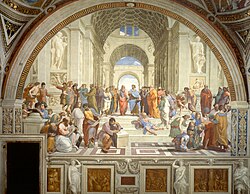
Back النهضة في إسكتلندا Arabic Renacimiento en Escocia Spanish رنسانس در اسکاتلند Persian Renesansa u Škotskoj Serbo-Croatian
| Renaissance |
|---|
 |
| Aspects |
| Regions |
| History and study |
| History of Scotland |
|---|
 |
|
|
The Renaissance in Scotland was a cultural, intellectual and artistic movement in Scotland, from the late fifteenth century to the beginning of the seventeenth century. It is associated with the pan-European Renaissance that is usually regarded as beginning in Italy in the late fourteenth century and reaching northern Europe as a Northern Renaissance in the fifteenth century. It involved an attempt to revive the principles of the classical era, including humanism, a spirit of scholarly enquiry, scepticism, and concepts of balance and proportion. Since the twentieth century, the uniqueness and unity of the Renaissance has been challenged by historians, but significant changes in Scotland can be seen to have taken place in education, intellectual life, literature, art, architecture, music, science and politics.
The court was central to the patronage and dissemination of Renaissance works and ideas. It was also central to the staging of lavish display that portrayed the political and religious role of the monarchy. The Renaissance led to the adoption of ideas of imperial monarchy, encouraging the Scottish crown to join the new monarchies by asserting imperial jurisdiction and distinction. The growing emphasis on education in the Middle Ages became part of a humanist and then Protestant programme to extend and reform learning. It resulted in the expansion of the school system and the foundation of six university colleges by the end of the sixteenth century. Relatively large numbers of Scottish scholars studied on the continent or in England and some, such as Hector Boece, John Mair, Andrew Melville and George Buchanan, returned to Scotland to play a major part in developing Scottish intellectual life. Vernacular works in Scots began to emerge in the fifteenth century, while Latin remained a major literary language. With the patronage of James V and James VI, writers included William Stewart, John Bellenden, David Lyndsay, William Fowler and Alexander Montgomerie.
In the sixteenth century, Scottish kings – particularly James V – built palaces in Renaissance style, beginning at Linlithgow. The trend soon spread to members of the aristocracy. Painting was strongly influenced by Flemish painting, with works commissioned from the continent and Flemings serving as court artists. While church art suffered iconoclasm and a loss of patronage as a result of the Reformation, house decoration and portraiture became significant for the wealthy, with George Jamesone emerging as the first major named artist in the early seventeenth century. Music also incorporated wider European influences although the Reformation caused a move from complex polyphonic church music to the simpler singing of metrical psalms. Combined with the Union of Crowns in 1603, the Reformation also removed the church and the court as sources of patronage, changing the direction of artistic creation and limiting its scope. In the early seventeenth century the major elements of the Renaissance began to give way to Mannerism and the Baroque.
© MMXXIII Rich X Search. We shall prevail. All rights reserved. Rich X Search